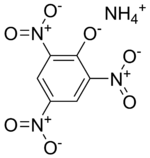- Dunnite
-
Dunnite  Ammonium 2,4,6-trinitrophenolateOther namesAmmonium Picrate; Picratol; 2,4,6-Trinitrophenol ammonium salt; Ammonium picronitrate; Explosive D
Ammonium 2,4,6-trinitrophenolateOther namesAmmonium Picrate; Picratol; 2,4,6-Trinitrophenol ammonium salt; Ammonium picronitrate; Explosive DIdentifiers CAS number 131-74-8 
PubChem 8577 Jmol-3D images Image 1 - C1=C(C=C(C(=C1[N+](=O)[O-])[O-])[N+](=O)[O-])[N+](=O)[O-].[NH4+]
Properties Molecular formula C6H6N4O7 Molar mass 246.13 g/mol Density 1.719 g/cm3[1] Melting point 265 °C[1]
Solubility in water 10 g/L (20 °C) Hazards R-phrases R3 R23/24/25 S-phrases (S1/2) S28 S35 S37 S45  (verify) (what is:
(verify) (what is:  /
/ ?)
?)
Except where noted otherwise, data are given for materials in their standard state (at 25 °C, 100 kPa)Infobox references Dunnite, also known as Explosive D or systematically as ammonium picrate, is an explosive developed by Major Dunn in 1906.[2] Ammonium picrate is a salt formed by reacting picric acid and ammonia. It may be noted as the first explosive used in an aerial bombing operation in military history, performed by Italian pilots in Libya in 1911.[3],La Stampa, November 2, 1911. It was used extensively by the United States Navy during World War I.[4]
Though Dunnite was generally considered an insensitive substance, by 1911 the United States Army had abandoned its use in favor of other alternatives.[5] The Navy, however, used it in armor-piercing artillery shells and projectiles, and in coastal defense.
Dunnite typically did not detonate on striking heavy armor. Rather, the shell encasing it would penetrate the armor, after which the charge would be triggered by a fuse .
In 2008 caches of discarded Dunnite in remote locations were mistaken for rusty rocks at Cape Porcupine, Newfoundland and Labrador, Canada.[6][7]
References
- ^ a b Record of Ammoniumpikrat in the GESTIS Substance Database from the IFA, accessed on 24. Nov. 2007
- ^ Dunnite Smashes Strongest Armor, The New York Times, August 18, 1907
- ^ [http://piste.blogspot.com/2011/03/ultime-notizie-bombardiamo-la-libia.html
- ^ Dunnite, Firstworldwar.com
- ^ Ridicule Spy Story: Army Abandoned the Use of Dunnite Years Ago, Officers Say, The New York Times, August 8, 1911
- ^ Mounties issue warning after explosives mistaken for rocks, Canadian Broadcasting Corporation, September 10, 2008.
- ^ "Beachcombing Labrador family carries home wartime explosive". Canadian Broadcasting Corporation. 2008-09-10. http://www.cbc.ca/canada/newfoundland-labrador/story/2008/09/10/rock-dunnite.html. Retrieved 2010-08-28.
Categories:- Explosives
- Picrates
- Ammonium compounds
Wikimedia Foundation. 2010.
